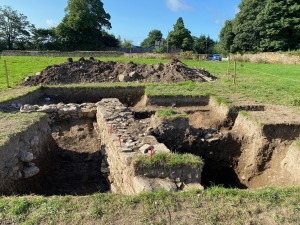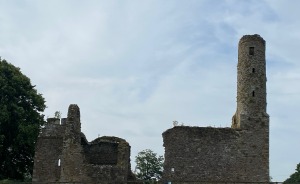By: Magen Hodapp
Characters such as Indiana Jones and Evie Carnahan of the Mummy present the most romanticized versions of archaeologists: people who find complete skeletons, intact mummies, and experience bizarre, cursed scenarios. Many cite these characters as their spark to pursue archaeology; in reality, archaeology is never quite as dramatic. The majority of archaeology is research, lab work, and writing, with only a small fragment of our careers dedicated to active excavation.

The end result of our 4 weeks of excavation. (right)
Regardless of the reality of an archaeology career, our first field schools are always incredibly exciting. The planning, the studying, the purchasing of new hiking boots and trowels – for us up-and-coming archaeologists, these are our first steps towards a career in the field. I chose a field school through IFR that took me to Ireland for a month to excavate a 12th century monastery, allowing me to start my work in a place I loved and wanted to return to. One of the primary reasons why field schools are so important in our field is because they offer much needed hands-on experience. Our professors can explain archaeological and ethnographic methods from a classroom setting all they want, but it will never be the same as us going out and doing it in the field ourselves. Something that is also best taught in the field is the importance of respect when working with people and materials.
As archaeologists, it can be easy to forget that the items and remains we find were once living in one way or another. A pottery sherd to us may just be an old piece of clay; to someone else, it was a functional part of their daily life. A singular tooth is seen as a boring anomaly, a poor substitute for a complete skeleton. An archaeological site is seen as a possible bounty for some news-breaking discovery rather than a place where people once slept, worked, and lived out their lives. A plastic skeleton is not real; therefore, we can name it and dress it up, even though the bones of that skeleton were taken and molded from someone who was never given any respect or credit for their contribution to the scientific community.
Having respect for the materials and individuals being discovered at our field schools and in our future careers is of the utmost importance in today’s climate. All items that we find at field schools or research excavations, even the smallest pottery sherd or stone flake, can allow for increased cultural understanding. Because of this, we as students must learn to treat every item with respect, regardless of our imagined scale of importance.
So, how do we do it? How do we have respect for the items as objective, scientific researchers?
The first step is to understand that we can conduct valuable, objective research and analysis while being empathetic. For many, this can be a difficult concept to understand – after all, one of the first things we learn is how to eliminate bias and focus on a culturally relativistic perspective. The answer is not to fall into one side of the spectrum or the other but learning how to view materials and remains with both kindness and an objective research-based mind. For example, if one is working with human remains and they find a pathology, they can note how interesting the pathology is while understanding that it likely caused that individual a great amount of pain. If you are working with pottery, you can understand that a small sherd may not represent much and also realize that it was likely made by an artisan who was gifted in their craft and provided a needed service to their community.
The remains of St. Aidan’s monastery. (Left)
The next step is to walk the fine line between respect and romanization, something that I myself still struggle with. It can be easy to create wild stories within our minds of the places we excavate, guessing about how someone may have passed, the specific lives people led, or what important person of history resided there. Walking this line takes practice and interaction with those more experienced than you. By talking and working with our professors, we can learn that even the instructors we value the most do not have all the answers. One of the most frustrating parts of archaeology is the fact that we will never get the full story of a place or person, except in very rare cases. There will always be one or more missing puzzle pieces that no amount of digging in trenches will find. So, it is always best to remain conservative in our interpretations. We can and should discuss the craftsmanship of Hopi pottery or innovation of a hunting strategy, especially if discussion with the respective group is possible, but should not try to make assumptions about who created it or their exact reasons.
At the end of the day, I am just a 21- year- old still learning about the field I love but, this semester has been the hardest yet. It would have been made easier with just a bit of kindness and respect. Therefore, I want to put the compassion I’ve been missing towards my work and encourage others to do the same.

